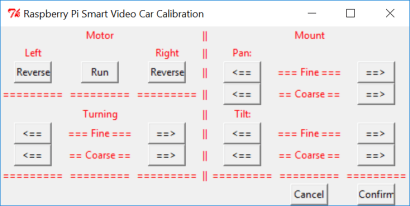Review: SunFounder Smart Video Car Kit for Raspberry Pi
Assembling the Smart Video Car Kit
I built the car step by step following the manual, and found that (except for the small print) it is very well done. Here are some things I learned along the way:- Page 17: respect the orientation of the servo rocker arm, refer to page 18 too; don’t tighten the screw too much, the beam must be able to rotate freely;
- Page 21, drawing ‘a’: the ribbon must be cut in two and threaded through the slits in the base plate;
- Page 22, drawings C & D, the acrylic plate looks symmetrical, but it isn’t. Make sure you have the right side up.
I didn’t bother to remove the protective film from the acrylic parts, giving my car a cardboard look.
Electrical wiring
When the mechanical assembly is done — it took me two hours — it is time to do the electrical part. As stated on page 30, this drawing is a preview, do not try to use it for wiring. It is correct, but not clear enough, and you should simply execute the steps in the pages that follow. Page 37 is the same as page 30. As with the mechanical parts, more than enough wires are provided.
Software installation
Next is setting up the software. This is usually the point where things go wrong and you end up with yet another piece of crap in your closet, but not in this case.I used an RPi2 model B v1.1; the manual shows an RPi1 model B+. On my microSD card (8 GB) I installed the latest version of Raspbian (2018-04-18-raspbian-stretch-lite) and using raspi-config I set up the RPi for my Wi-Fi network. Also enable SSH, and the I²C interface.
Now install git (use the command given on page 44, Step 2, method 1 ‘For Ubuntu/Debian’) and then do Step 1 on page 44. Install Python as indicated at the top of page 46, activate the I²C interface if you didn’t do so already and terminate with the MJPG streamer. If you don’t make any typing mistakes, this all works flawlessly.
Read full article
Hide full article


Discussion (1 comment)